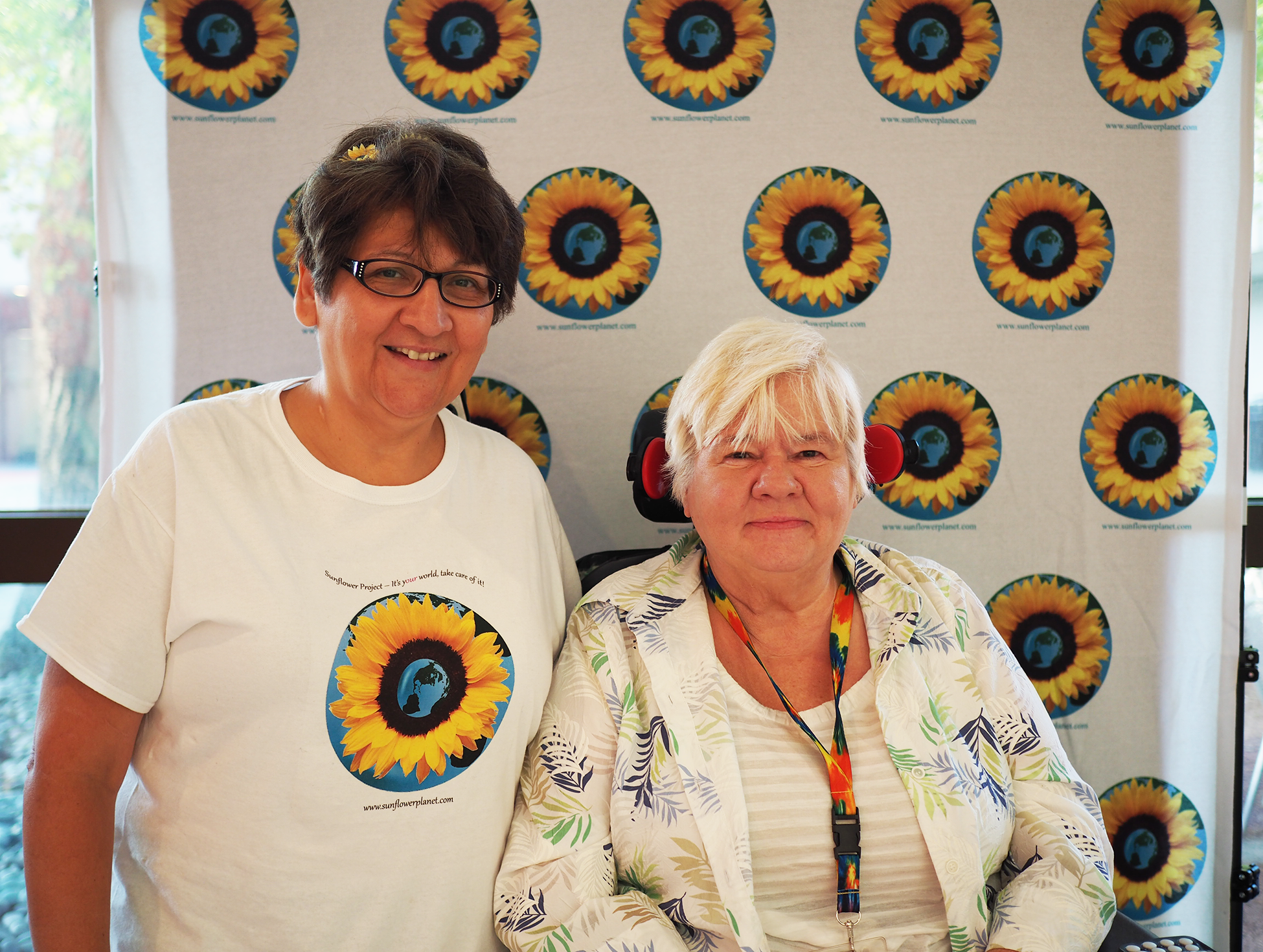A sunflower begins as a seed. It is a compact, quickly forgotten speck resting in the palm of a hand. But let that seed drop into soil and provide it with water, and it will shed its coating and sprout a stem, leaves, and eventually, flower. For Kathy Fitzgerald and Rita Alvarez, this is how their organization, the Sunflower Project, began: from a small idea and a big passion.
The purpose of the Sunflower Project is beautiful in its simplicity: to plant one mammoth sunflower at every utility or light pole in the city of Chicago and beyond. To put it in other terms, Fitzgerald said, “Our primary goal is to make you smile.” A smile is in fact what inspired the idea to begin with.
Fitzgerald and Alvarez met twenty-seven years ago, marching together in Washington D.C. for the Americans with Disabilities Act; they have been together ever since. After planting mammoth sunflowers—a variety that can grow over ten feet tall, looking prehistoric in size—in front of their home in 2013, the women noticed just how many smiles the flowers produced. At that time, they dreamed of spreading the radiance, friendliness, and youthfulness of sunflowers through both planting and education. Just two years ago, they decided to realize their dream. All it takes to start is poking a small hole in the ground, dropping one seed in, and covering it with dirt.
“We just decided, I can do that,” Fitzgerald said. “And you just have to do it.” She gave me a knowing smile, telling me that people are oftentimes reluctant to begin something new, or starting community work from scratch. “But you have to find your own passion.”
In 2016, the first year of the project, they planted just in their immediate community on the Far Southeast Side. However, this year, Alvarez and Fitzgerald already expect to plant 132 flowers with the help of two schools. This educational aspect of their project involves teaching students from the South Side through classes, a Smart Museum tour, and planting. What exactly does the Sunflower Project teach students? “Quite simply, beauty, purpose, and art,” Alvarez said.
Alvarez and Fitzgerald lead artistic classroom activities that teach students about gardening and plant science; they also take a tour of the Smart Museum. Then, they take their students into their communities to plant the flowers. The project’s seed is beginning to sprout as it builds connections with six different schools and with organizations like the Garfield Conservatory, Fitzgerald said. Soon, it will blossom.
On May 11, Alvarez greeted me with her smile and led me into Hyde Park’s Smart Museum of Art for their annual fundraiser that raised money to pay for the costs of filing for 501(c)3 status, which would allow the Sunflower Project to officially become a tax-exempt nonprofit. She quickly introduced me to Fitzgerald and the members of the board, including President Dawn Pilota-Klien, Vice President Josephine McEntee, Treasurer Celia Campos, and Secretary Jason Pallas. Each had their own story to tell, their own vision to share, yet all converged on a similar passion and love for helping their communities.
Alvarez and Fitzgerald are both docents at the Smart Museum, and Fitzgerald and McEntee are both graduates of the Odyssey Project, a program that offers a free, yearlong education in the humanities to residents of the South Side. Through the Smart Museum, they met Pallas, who organized classroom sessions to teach youth from the South Side about the environment and community service as part of the project. They soon met Erika Dudley, the senior program manager of the Odyssey Project, and the glue of the entire Sunflower Project. Dudley brought everyone together, inviting Alvarez and Fitzgerald into the community of the University of Chicago and the Smart Museum, which in turn gave them resources to kick-start their project.
The women I met also called notice to their age—many of them are in their sixties. Fitzgerald talked about how people reach a certain point in their lives and think that they don’t have anything left to offer. “It’s about just trying to be the best that we can be,” McEntee said, “And that doesn’t have to stop at a certain age.” The women proved that you don’t need anything but passion and commitment to do something good for the community. “[It’s] the benefits of the little things, growing little by little—this is what sets [the Sunflower Project] apart,” Dudley said.
Did you like this article? Support local journalism by donating to South Side Weekly today.


Amazing story
Inspiring!
What goes beyond the Sunflower Project is the idea that you can do something seemingly insignificant…plant sunflowers…and make a difference. In too many communities, there is nothing beautiful..but with sunflowers (or any other flower) there is always beauty.
This article is written with elegance and economy, style and skill. The imagery of the sunflowers bloom with the same beauty and brilliance that the Sunflower Project itself brings to its community. A wonderful example of how creative coverage can change the world.